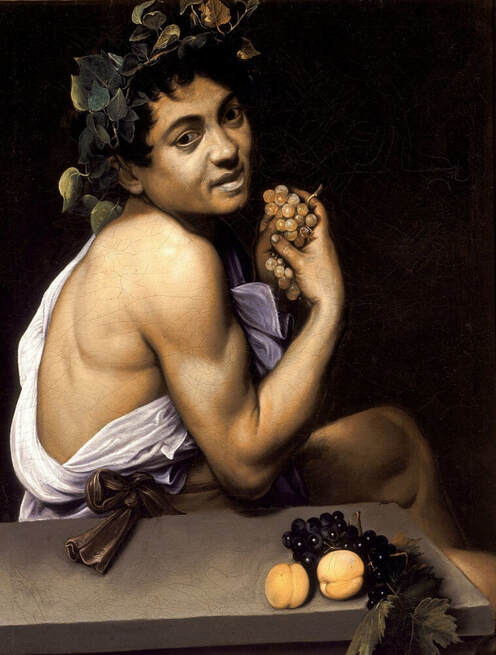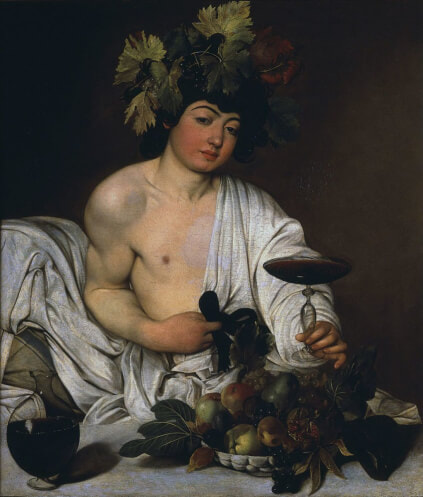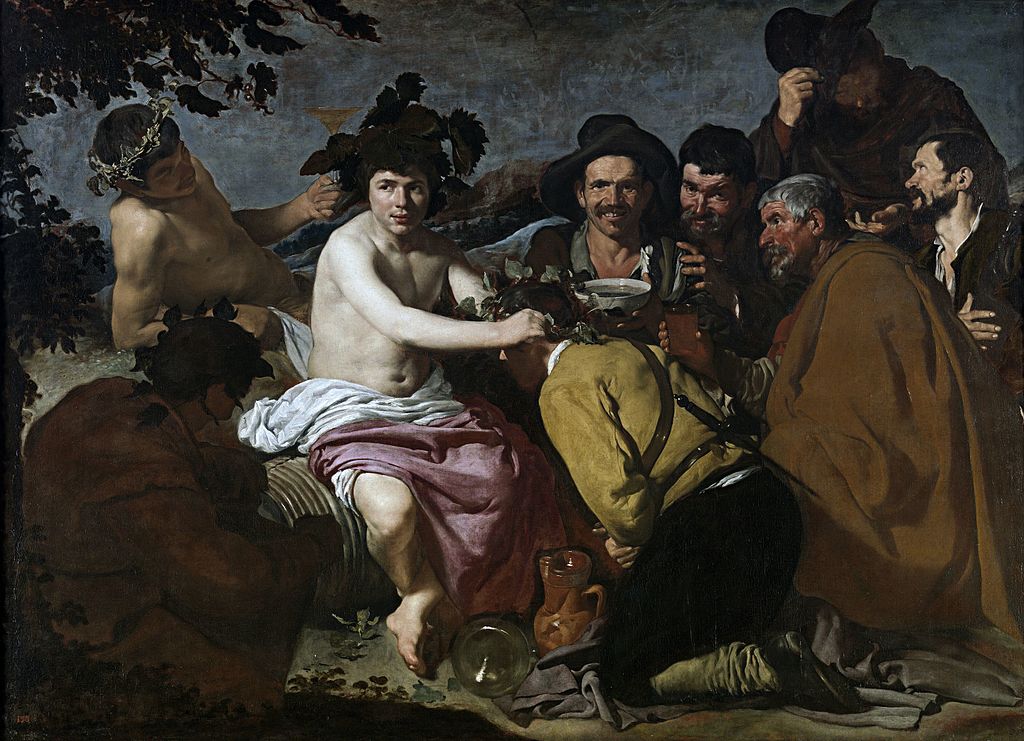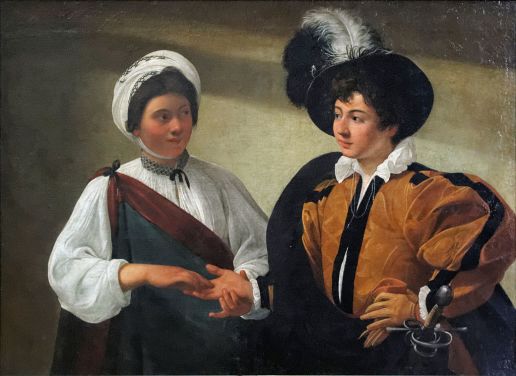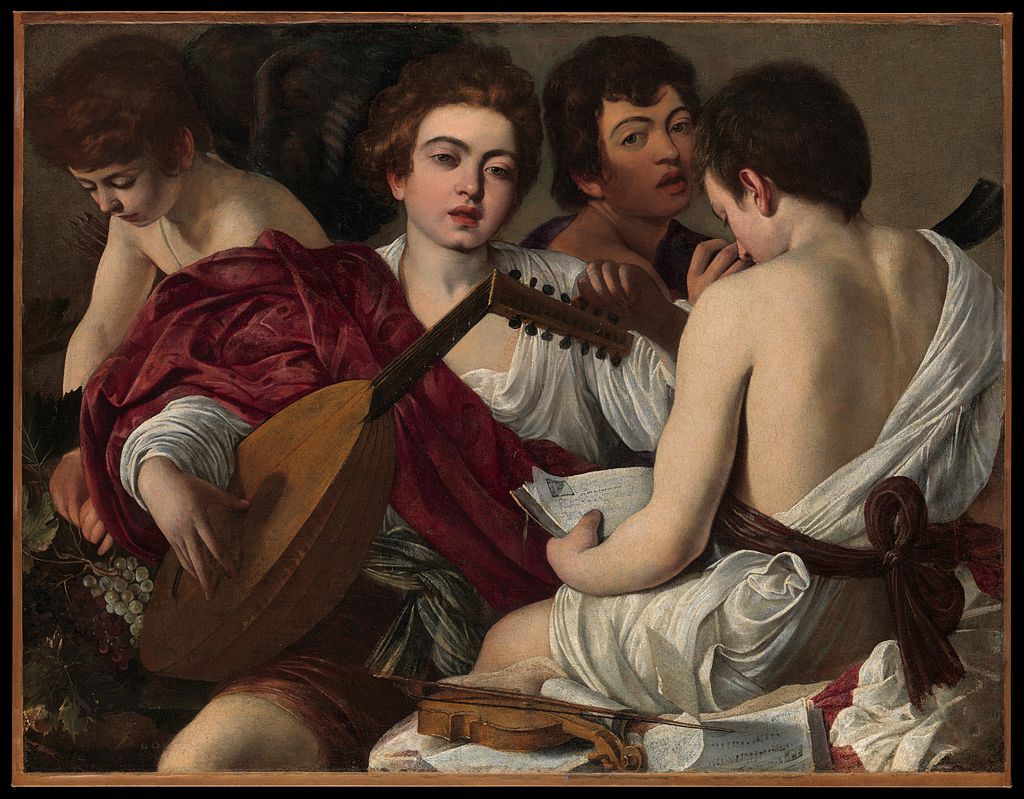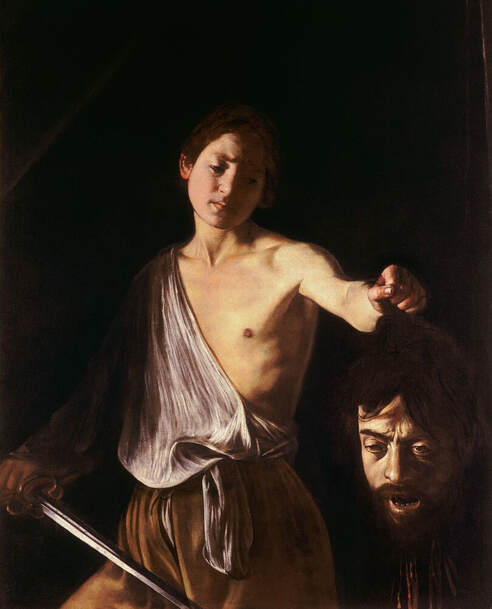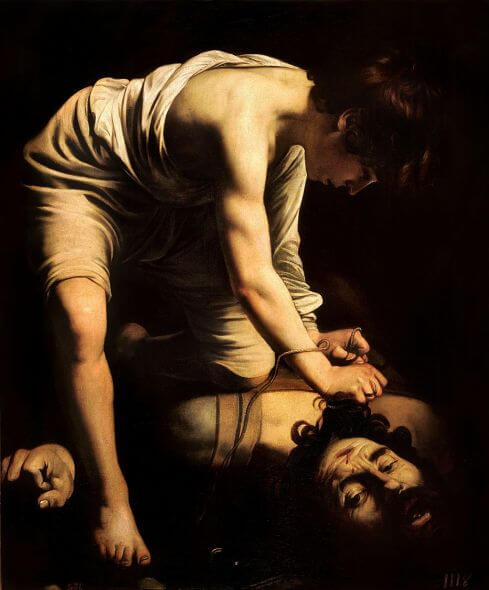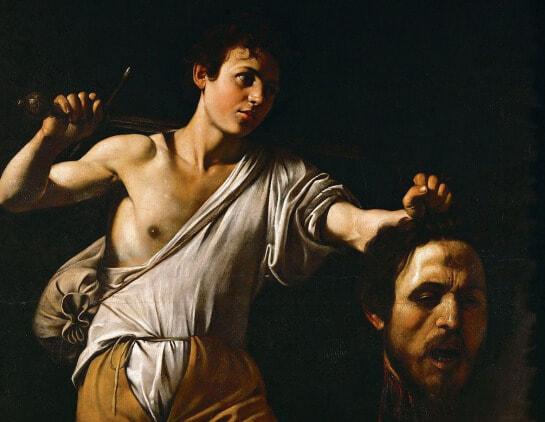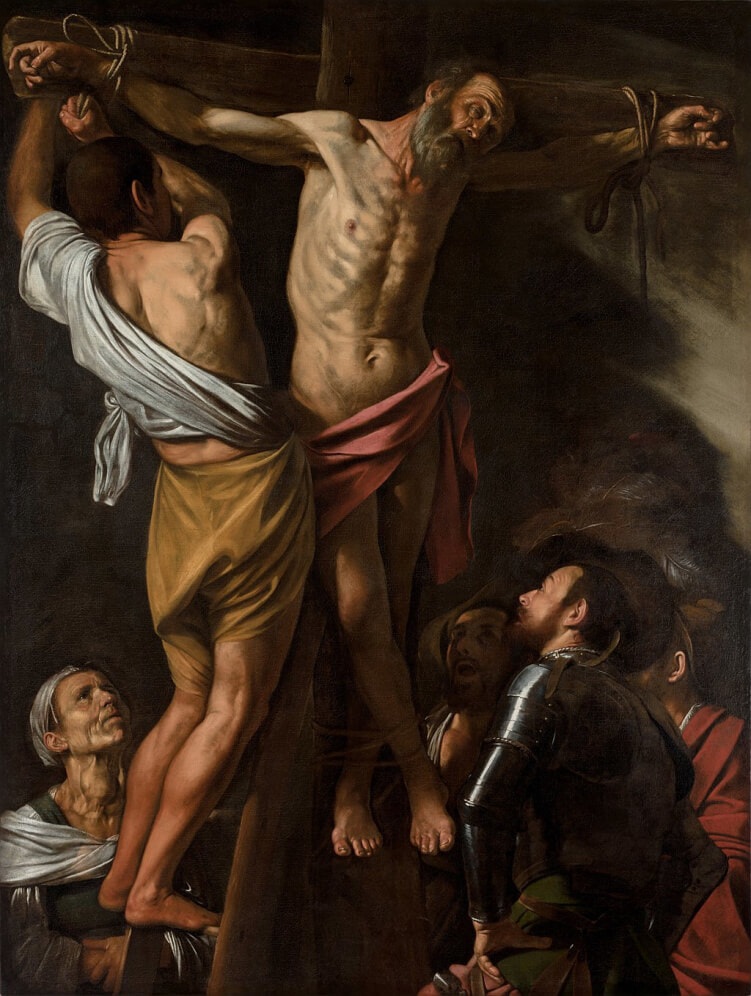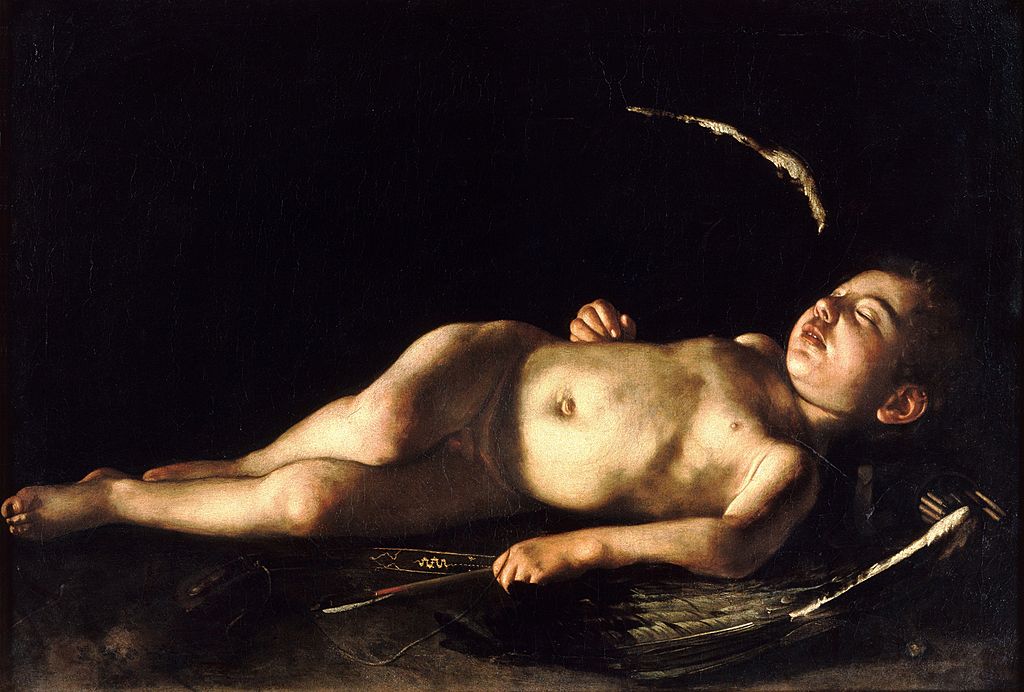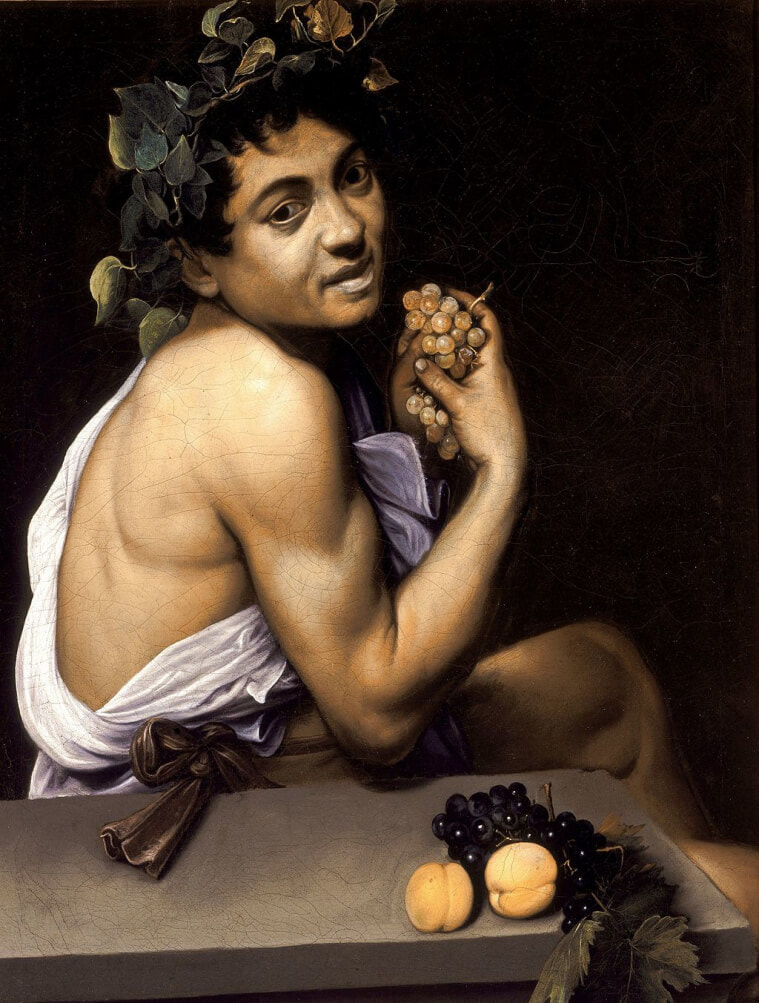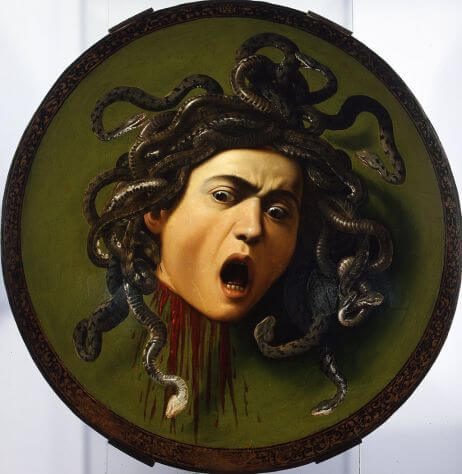|
Where? Room VIII of the Galleria Borghese
When? 1593-1594 Commissioned by? Unknown; Caravaggio probably used this painting to market himself for commissions. What do you see? A self-portrait of Caravaggio. He poses as the Roman god Bacchus, the god of grape harvest, wine, and intoxication. He is half-naked, wearing a white robe, and the ribbon around his robe lies on the table. We can see his muscular shoulder and arm. However, Bacchus does not look healthy. His skin is yellow and the white part of his eyes as well. Also, he has bluish lips. He wears a crown of ivy leaves on his head. He folds his hands and holds a bunch of white/yellow grapes between them. Bacchus sits at a stone table with on top a bunch of healthy black grapes, two peaches which have a similar color as Bacchus’ skin, and some vine leaves. Backstory: This painting is also known as ‘Sick Bacchus’ or ‘Self-Portrait as Bacchus.’ Caravaggio used a mirror to paint this work as he did more often later in his career. He probably painted it between 1593 and 1594. In 1607, the painting was confiscated by the Pope because of tax evasion by its owner, Giuseppe Cesari. The Pope gave the painting to his nephew, Scipione Caffarelli-Borghese. The painting was still reported to be in the Borghese collection in 1693. As the painting does not have a signature of Caravaggio, over the next centuries, it was attributed to several other painters. In 1927, it was attributed to Caravaggio again, and the large majority of people believes that this is a real Caravaggio. Who is Bacchus? Known in Greek mythology as Dionysus, Bacchus was the son of Zeus and Semele. He was the god of ecstasy, fertility, grape harvest, wine, and winemaking. He was a popular subject for artists as it allowed them to depict earthly pleasures. Around 1595, Caravaggio painted another painting of Bacchus which is in the Uffizi Museum. In contrast to his first painting, Bacchus looks quite healthy in that painting. Another example of an artist who has used Bacchus as the subject of his art is Diego Velázquez. He painted The Triumph of Bacchus in the Prado Museum.
Symbolism: The crown of ivy leaves is a symbol of Bacchus. Ivy was a sacred plant for Bacchus as it was thought to possess the power of preventing intoxication. The bunch of grapes also contains some rotten grapes. This is a symbol of death which is always looming and must have been in the mind of Caravaggio when he was in the hospital for a long time before he created this painting. At the same time, he holds the bunch of grapes close to his mouth suggesting that he is available for some intimacy. This suggestion is also emphasized by the ribbon of his robe, which is explicitly shown on the table and is ready to be opened. Moreover, the two peaches on the table symbolize a desire to be together with someone else.
Who is Caravaggio? Michelangelo Merisi Caravaggio (1571-1610) was born in Caravaggio near Milan, Italy. In 1592, he fled to Rome due to some trouble with the police. He arrived in Rome with almost no money and no place to live. Moreover, he got seriously ill and spent six months in the hospital. Luckily, he was a very talented painter. During his recovery, he painted Young Sick Bacchus. At the beginning of his career, he focused on naturally and realistically depicting human subjects and other elements in his paintings. This was very uncommon and makes the work of Caravaggio unique. To emphasize the imperfections of life, Caravaggio would get the models for his paintings from the streets (like beggars and prostitutes) and would buy some fruit on the market, accepting the fact that the fruit did not look perfect. Early in his career, Caravaggio also painted The Fortune Teller in the Louvre and the Capitoline Museums, and The Musicians in the Metropolitan Museum of Art.
Fun fact: Caravaggio was recovering from a serious illness when he painted this work. There are several theories on why he was in the hospital, ranging from a serious kick of a horse to malaria. However, during his recovery, there were still signs of sickness as we can see in this painting. He has jaundice, which leads to a yellowing of the skin and the white part of your eyes. It makes sense that Caravaggio used himself as the model for this painting. He was very poor in the beginning of his career (and also not rich during the rest of his life), and Caravaggio himself was the cheapest model he could find for this painting.
Interested in a copy for yourself? Poster or canvas.
0 Comments
Where? Room VIII of the Galleria Borghese
When? Around 1610 What do you see? David holds the head of Goliath after he defeated Goliath in a one-to-one battle. The painting is full of contrasts. David is depicted in the light as a young, strong, and lively man. He wears a wrinkled white cloth that is tucked into his beige pants. He is clean-shaven. He holds the sword of Goliath in his right hand and the head of Goliath in his left hand. He looks at the head of Goliath with a calm but somewhat sad expression. Most of the composition is dedicated to David. In contrast, only the lower right of the composition is dedicated to Goliath who is depicted as an ugly, old, and defeated man. You can see the blood on his forehead, which is the place where David hit him with a stone. His eyes are still knitted, showing his reaction when he saw the stone flying towards his forehead. He has a large beard and an open mouth with rotten teeth. His head is already decaying, and a large amount of blood is dripping out of the bottom. On top of the blade of the sword is an inscription reading ‘H-AS OS.’ This refers to the Latin for ‘humilitas occidit superbiam,’ which means ‘humility kills pride.’ Backstory: Caravaggio probably painted this work while he was in Naples and this may have been the last work that he completed during his life. However, there is some doubt about the exact date of this painting. Some people think that it could have been painted as early as 1605. Popular belief, though, is that this is indeed the last painting by Caravaggio (which makes this painting more special). Francesco Boneri (also known as Cecco del Caravaggio, but no family of Caravaggio) is probably the model for David. He was a servant and pupil of Caravaggio and a moderately talented painter himself. However, some people believe that David is based on a self-portrait of a younger Caravaggio. Other versions by Caravaggio: Caravaggio painted David with the Head of Goliath a total of three times. In 1600, he painted his first version which is on display in the Prado Museum in Madrid. In this version, David is tying the hair of Goliath with a rope after he cut off his head. In 1607, Caravaggio painted his second version which is on display in the Kunsthistorisches Museum in Vienna. This second version is most similar to his final version. The main differences are the age of of Goliath and the way in which David holds his sword.
David and Goliath: 1 Samuel 17 describes the story of David and Goliath. Israel was at war with the Philistines. The Philistines had a hero called Goliath who was over 9 feet (2.75 meters) tall. Goliath proposed every day to the Israelites that instead of letting the armies fight each other, they should send one man to fight him. If Goliath would win the fight, the Israelites would become slaves of the Philistines, and if Goliath would lose, the Philistines would become slaves of the Israelites.
David convinced King Saul that he should fight Goliath. He went out of the army camp to meet Goliath, wearing no armor, only bringing a walking stick, a sling, and a bag with five smooth stones. He put a stone in his sling and threw it at Goliath, hitting him between his eyes. Goliath fell, and David took Goliath’s sword to behead him. He took the head of Goliath back to Jerusalem but kept the sword and spear for himself. Who is Caravaggio? Michelangelo Merisi da Caravaggio (1571-1610) was born in Caravaggio near Milan, Italy. Caravaggio lived a turbulent life, and in 1606 he killed a man (though it is not clear whether that was intentional). To avoid a conviction, he fled and lived until 1610 in Naples, Malta, and Sicily. In 1610, he had hopes that he would be pardoned for his crime, and he returned by boat to Rome with several of his paintings. When the ship arrives near Rome, Caravaggio gets arrested, and the ship leaves with his belonging for Porto Ercole. Caravaggio pays a bond to get out of jail and starts to follow the ship on foot to recover his belongings. However, he gets ill on the way and dies from a fever in Porto Ercole on July 18, 1610. While he died young, Caravaggio has left behind many popular paintings, including his The Crucifixion of Saint Andrew from 1606-1607 in the Cleveland Museum of Art and Sleeping Cupid from 1608 in the Palazzo Pitti.
Fun fact: Caravaggio probably used his own face as the model for Goliath in this painting. There are different explanations for why he did this. The conventional explanation is that he used himself as the model for Goliath to ask forgiveness from the Pope for the crimes he committed while he was in Rome.
An alternative explanation is that Caravaggio was just a rebel at heart and this was another way in which he expressed his rebellious nature. If one also believes that David is modeled after a younger Caravaggio, it would provide a more bizarre explanation for this painting. Specifically, it would mean that the young Caravaggio (through his wild behavior) has destroyed the life of the older Caravaggio. He used himself as a model in multiple paintings during his career, including Young Sick Bacchus in the Galleria Borghese and Medusa in the Uffizi Museum. Interested in a copy for yourself? Poster or canvas. |
Categories
All
|
- Home
- Blog
-
Museums
- Alte Pinakothek
- Art Institute of Chicago
- Baltimore Museum of Art
- Barber Institute of Fine Arts
- Bargello
- Barnes Foundation
- British Museum
- Church of Sant’Anastasia
- Cleveland Museum of Art
- Courtauld Institute of Art
- Detroit Institute of Arts
- Frans Hals Museum
- Galleria Borghese
- Gallerie dell'Accademia
- Getty Museum
- Guggenheim
- Hermitage Museum
- Kunsthistorisches Museum
- Kunstmuseum Basel
- Legion of Honor Museum
- Louvre
- Mauritshuis
- Metropolitan Museum of Art
- Musee d’Orsay
- Museum of Fine Arts in Boston
- Museum of Modern Art
- National Gallery in London
- National Gallery of Art
- National Museum in Poznań
- Norton Simon Museum
- Ny Carlsberg Glyptotek
- Palace of Versailles
- Palazzo Pitti
- Palazzo Vecchio
- Petit Palais
- Philadelphia Museum of Art
- Prado
- Pushkin Museum
- Ravenna Art Museum
- Rijksmuseum
- San Diego Museum of Art
- Santa Maria delle Grazie
- St. Peter's Basilica
- Städel Museum
- Statens Museum for Kunst
- Tate Britain
- Tate Modern
- Timken Museum of Art
- Uffizi
- Vatican Museums
- Wallace Collection
-
Artists
- Altdorfer
- Anguissola
- Berlin Painter
- Bosch
- Botticelli
- Boucher
- Bronzino
- Bruegel the Elder
- Brunelleschi
- Cabanel
- Caillebotte
- Canova
- Caravaggio
- Carpeaux
- Cezanne
- Cimabue
- David
- Degas
- Delacroix
- De Maria
- Donatello
- El Greco
- Fontana
- Fra Angelico
- Fragonard
- Gauguin
- Gentileschi
- Gericault
- Gonzalez-Torres
- Goya
- Hals
- Hogarth
- Hokusai
- Ingres
- Leonardo da Vinci
- Lippi, Filippo
- Longhi, Barbara
- Lorrain
- Makovsky
- Manet
- Massys
- Matisse
- Merian
- Michelangelo
- Mochi
- Modigliani
- Monet
- Panini
- Parmigianino
- Perugino
- Picasso
- Pisanello
- Raphael
- Rembrandt
- Renoir
- Reynolds
- Rivera
- Rodin
- Rubens
- Scultori
- Seurat
- Steen
- Tintoretto
- Titian
- Toulouse-Lautrec
- Turner
- Uccello
- Van der Weyden
- Van Dyck
- Van Eyck
- Van Gogh
- Van Hemessen
- Vasari
- Velazquez
- Vermeer
- Veronese
- Vigée Le Brun
-
Locations
- Books
- About Us

